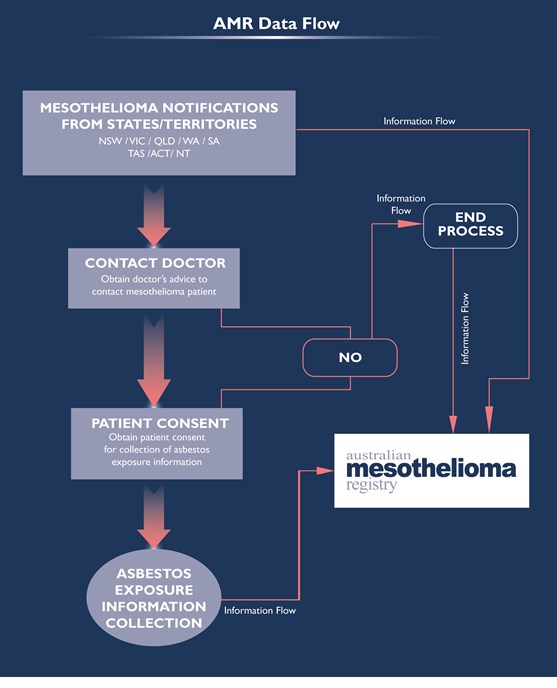How does the AMR work?
Notification and recruitment of mesothelioma patients
Each state and territory cancer registry provides the AMR with information about each person diagnosed with mesothelioma on or after 1st July 2010 in Australia.
People who were diagnosed with mesothelioma can also self-notify to the AMR.
When a notification of a mesothelioma diagnosis is made to the AMR, the relevant state or territory cancer registry will approach the patient's doctor to obtain their advice on whether their patient meets various eligibility criteria. The criteria include confirmation of mesothelioma diagnosis on or after July 1 2010 and that they are well enough to be contacted about their exposure to asbestos. If eligible, the registry then contacts the patient and sends them a Patient Information Pack which includes a Patient Consent Form and the Postal Questionnaire for them to complete at home.
For people who self-notify, a Patient Information Pack can be mailed out to them by calling the AMR Information Line.
The typical process for patient recruitment is shown in Figure 1 below:
Figure 1

Asbestos Exposure Information Collection
Asbestos exposure information is collected from consenting mesothelioma patients in 2 stages:
1. Postal Questionnaire: Patients are asked to list their residential and occupational histories. Patients are also asked about their family history of mesothelioma.
2. Telephone interview: A 10-30 minute interview will be conducted to assess their potential asbestos exposure.
The Monash Centre for Occupational and Environmental Health (MonCOEH) uses the information from the Postal Questionnaire to assign specific questions for each person. This means the telephone interview is tailored to each participant so that the interview time is reduced. Then the telephone interview company (Social Research Centre) conducts the telephone interviews. The information collected is used by MonCOEH staff to assess the patient's past exposure to asbestos throughout their lifetime.
The typical process for asbestos exposure information collection is shown in Figure 2 below:
Figure 2

Top ^

